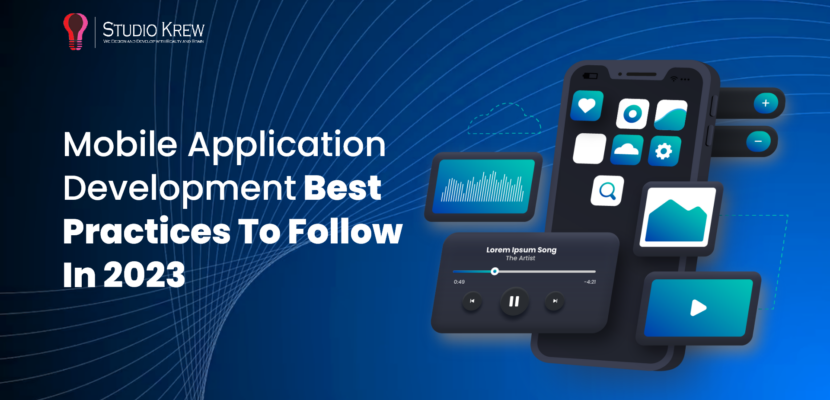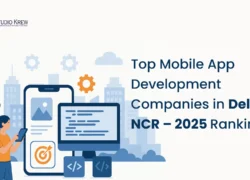In the ever-evolving world of technology, mobile applications have become an integral part of our lives. As businesses strive to stay ahead in the digital era, creating a successful mobile app has become crucial. However, developing a mobile app that stands out from the competition can be challenging. To ensure the success of your mobile app in 2023 and beyond, it’s essential to follow industry best practices. Being a Top Mobile App Development Company in the USA, UK, and UAE StudioKrew through this blog post, we will explore the reasons behind mobile app failures and highlight the top mobile app development best practices to follow this year.
Building a mobile app is intimidating, whether you’re an old hand or a beginner. Several things are to be taken into account so that the final result comes in line with the client’s goal and the mobile hardware. Over the years mobile devices have been fortified with countless features like GPS, cameras, near-field communication, and so on. For sure, these updates have unleashed new opportunities but at the same time made mobile app development further complicated. Being the Top Mobile App Development Company, StudioKrew
Anyone who wants an application nowadays looks to include as many features as possible to withstand the presence and outrun the popularity of web applications. Thus, developers too have to grind hard so the maximum possible features can be integrated into the hardware of mobile devices, which is not much powerful.
You might be surprised to know, that of all the mobile applications launched on the app stores, most of them, (90% to be precise), are deserted just after a single use. So, before considering mobile application development it is crucial to understand why most of them fail, so you steer clear of those mistakes.
Why Do Most Mobile Apps Fail?
Well, the tragedy can be traced back to four reasons which we’ll explore here in a bit detailed manner. Read on!
Poor User Experience
“If users find an application too problematic to use, it won’t be long after they would have abandoned it”, claimed a survey. But what’s the main culprit of bad user experience when it comes to mobile apps? Well, it can be unintuitive navigation, longer page loads, feature inaccessibility, and lengthy signup processes, to name a few. So, make sure, you keep things smooth and interactive for your users, so they can enjoy a satisfying experience with your mobile application.
Robust Mobile App Architect
A solid mobile app architecture is the foundation for a successful app. It involves structuring the app’s components, layers, and patterns in a way that ensures scalability, maintainability, and extensibility. Mobile App product fails and requires heavy Investments to add new features or Modules as per Audience or Business Team demand. So make sure, you develop the Mobile App in such a way that there is always flexibility to add new features in it or scope of incorporating Business Team recommendations with minimal investments.
At StudioKrew, we believe in doing detailed product research before finalizing the complete Mobile App and Backend architecture. Here are the core points we focus on to understand the requirements better:
- We build a Spec Sheet for your product or vision requirement.
- We get a broad range of target timelines and understand the budget allocated for product development.
- We analyze a sample product or use case to estimate the traffic, concurrency, and any other predictive challenges.
- We understand the future vision from the perspective of both the product owner and the user.
Understanding how your products are made can save you a lot of time and money. If you have any requirements around Mobile App Development, Android App Development, iOS App Development, React Native App Development, and Mobile Game Development services, feel free to reach out to our Business team.
Poor Scalable Backend Architect
Imagine you have invested your time and cost to develop a Mobile App, Increase your Audience, and Start making revenue out of it. But suddenly you got to know that the product is limited with the High User Concurrency or Database Consumption. Ouch! now what will you do? Will you ask your audience if we can not manage more user requests due to scalability issues or limit your business growth or you prepare your team to sacrifice your team’s effort for extra development time and scale your existing product by infusing extra Development Costs?
The backend architecture of a mobile app is responsible for managing data, handling requests, user concurrency, and supporting the app’s functionality. A scalable backend architecture allows the app to handle increasing user loads and maintain performance even as the user base grows. It will not only save your future operation costs but also reduce your stress once your product builds a huge audience.
Failure To Solve A Real-World Problem
People turn to applications for inviting efficiency into a particular task or resolving a specific issue. But if an application fails to do any of that, it is doomed to fail. Your application might be well-built, has amazing features, and also offers a great user experience, but when it comes to solving a real-world issue, it sucks. In that case, expect nothing but failure again.
No Unique Value Proposition
Another reason that contributes to the doom of a mobile application is the lack of an original idea. Many times, businesses and enterprises do not strive to come up with a unique idea that would add value to their users’ lives, instead, they take the shortcut by imitating their competitors. The lack of a unique value proposition in the mobile application idea will only lead to it being lost in the infinite pile of apps on the web.
Lack Of Clear Monetization Strategy
Making money off the app is one of the main goals of businesses. But if it fails to do so even after providing the best solutions to the real-world issue and offering value to users, then, it’s a virtually futile effort. To evade this, it is important to have an effective & comprehensive monetization strategy, so your app prospers and scales amid competition.
Not Deploying Robust Architecture
Loose application architecture becomes a big boulder in the way of fulfilling customer demands by causing issues with uptime, scalability, etc. That ultimately results in a drop in agility and increased time-to-market. On the other hand, robust and agile architecture renders mobile applications scalable and efficient as it focuses on continuous integration, deployment, and zero downtime.
Heavy-Build Download Size
Not only do larger download sizes of applications take longer to download but take up a lot of space for installation in the user’s device. Users are particularly in favour of applications of lower size as they download faster, use less device storage for running, and usually do not crash. So, ensuring optimal application size is crucial to consider during mobile app development that will take your app far.
Not Focusing On Backend Support
Strong backend support is an ultimate requirement for an app to run smoothly and stay stable during irregular traffic influx moments. Especially, if your application is for gaming or e-commerce purpose, the backend will support your business by efficiently handling traffic inflow which would otherwise affect it seriously for a long time. When considering a robust backend, make sure you keep scalability too in focus.
Poor App Store Optimisation (ASO)
Ignoring ASO practices such as keyword optimization, appealing descriptions, and engaging visuals can hinder app discoverability and visibility in app stores.
For your mobile application to stay stable and scalable, you should always consider the Mobile App Maintenance and LiveOps services from a leading app & game development company like StudioKrew.
If you have any query regarding backend, app, or game development, get in touch with StudioKrews’ business team to get it resolved.
These reasons have set the ground for us to proceed to understand the best practices to follow during mobile app development.

Best Practices For Mobile App Development
Crafting a solid mobile app that not only wins the heart of users but withstands the competition is challenging and for sure, expensive. But with the best practices, one can bring down the project cost and develop a solution that’s efficient and up-to-date.
In 2023, following best practices for mobile app development is crucial for success. By prioritizing user experience, optimizing performance, implementing robust security measures, and conducting thorough market research, developers can create exceptional mobile applications. Here, we’ve enlisted some of the best practices we’ve deployed over the years of experience in the field of app and game development.
StudioKrew, being a top mobile game development company and leading mobile app development company, understands the importance of these best practices and strives to deliver outstanding mobile solutions. From user-centric design and offline functionality to rigorous testing and continuous updates, adhering to these practices can lead to successful mobile apps that captivate users and drive business growth. For any project discussion or looking for a helping hand, you can reach out directly to our Business Team for a detailed discussion and a free quote. Contact Now!
Perform An In-Depth Research
To ensure you don’t fall through the cracks, conducting thorough research on the idea, budget, customer needs, limitations, market, etc., is of great importance. Make sure you take note of the following points before diving into the mobile app development journey:
- Look at the financial considerations: Analyse the complexity of the cost structure to have a better idea of the financial resources you can afford for development. Furthermore, look at the net and gross income trends and see if the budget can facilitate a smooth mobile app development journey.
- Identify the target audience and its needs: By knowing your audience, not only you’ll be able to enhance the user experience and interactivity of your application but also get to estimate the downloads and number of active users for the mobile app post-deployment. Carrying out the demographics research will also help you discover the best customer acquisition channels.
- Consider competitors & other barriers: Competitor research is crucial whichever niche you’re endeavouring to venture into. See what their goals and objectives are and whether your idea will be able to make it ahead of the crowd. Analyze their strengths and weaknesses and utilize the insights during your mobile app development.
Before and throughout the mobile app development process, you will have to monitor everything, so you can map out challenges and potential issues that may arise.
Choosing A Development Method
Now, that you’ve come so far in your research, you would be aware of different development methods. There are different kinds of mobile applications such as cross-platform, web-based, and native apps. While opting for a development method, make sure you have an estimate of your resources, goal, and an understanding of the mobile app’s nature you wish to build.
Follow the approach well in line with the programming language and tech framework you are familiar with and that it is suitable for the kind of application you’re looking for.
See, for instance, web-based applications are great when it comes to providing seamless mobile views with no app store constraints. While native mobile app development is popular for offering awesome user experience but can be pricey as you’ll have to focus on a single platform at a time. Furthermore, cross-platform applications are preferable if you aim to target a wider audience within a limited budget.
Selecting The Platform
So, which platform would you want your application to run on, Android or iOS? It isn’t easy to choose the right platform for your mobile application as there’s an algorithm governing this step too.
Nonetheless, with this best practice, you will be able to narrow down your prospective audience at a much deeper level. That’s because stark differences have been noticed in the behaviours of Apple and Android users. So, the insights from this research will pay off during the development process. Each platform has its own set of requirements, development tools, and design guidelines. Typically Swift or Objective-C is used for the development of iOS applications, on the other hand, Android apps are typically built with Java or Kotlin.
The selection of an app platform significantly impacts development costs in terms of the tools & programming languages, respective store licensing fees, device fragmentation, app store guidelines, and distribution channels.
Putting Security First
A mobile app takes users’ sensitive data to serve them. So, prioritizing user security is of utmost importance while developing mobile applications. The information of the user an app demands varies with different applications and their functionalities. Regardless of that, the application owner must preserve user information with maximum security.
To achieve this, you must strive to write a secure code, use authorized APIs only, encrypt data, and deploy high-level user authentication measures. These are just some ways to ensure the security of the user in your mobile application.
Testing & Optimizing App Performance
Testing continuously will help you monitor the performance of the application by revealing glitches, bugs, and errors. See, mobile app development isn’t a one-time process but rather an ongoing one where you need to test and find bugs regularly and even seize last-minute errors that affect app performance.
Keep UX/ UI In Focus
Of course, developers and designers are from different domains but they must collaborate and see if everyone is on the same page. Developers must focus on the design components to write code for the app in correspondence with the design.
The continuous collaboration will ensure effective work and consistent results by streamlining the development process reducing the possibility of introducing a great number of changes. It is a suggested practice to organize design elements in the early stages of the development process.
Build Around A Robust Core
It is the core around which all the other features of the application revolve. Thus, it is crucial to ascertain that the core is robust right from the planning stage. You can create an inventory of the features you want to see in the application and then, enlist them based on their importance. This feature hierarchy will guide you during mobile app development and you’ll know what to execute first.
Additionally, for applications with lengthy program codes, use plugins in the later stages of development as they will facilitate organization throughout the building process.

Keep the User Experience First
Your app is meant to go into the public and serve folks there. So, start by understanding the perspective, needs, and preferences of the end user. This knowledge will equip you with invaluable information to offer them the best experience, thereby, reducing the chances of app uninstallation and abandonment to a great extent.
Ask For Feedback
To develop your app properly, getting continuous feedback is of immense significance. For sure, beta testers will offer feedback but you can always touch base with other developers for advice and opinion. It is virtually impossible to view your project progress from an unbiased perspective, so, you may fail to notice something that may affect app performance. Also, reaching out to industry experts and professionals with whom you are well-acquainted is a great idea. Ask them for their valuable feedback & constructive criticism.
Adhere To App Store Development Instructions
App stores have guidelines for different kinds of applications which must be strictly followed to develop an application that can be launched without hassles. Knowing the best practices and regulations for the Google Play Store and Apple App Store is crucial if your app is meant to be released on any of these platforms. Not following the directions of the app store will lead to app rejection. So, see into the matter to avoid any issues or delays during the development process.
Include Accessibility Features
Make your app support the inclusivity of people with disabilities by integrating features like captions, voice assist, text enlargement facility, and so on. Focus on this factor during the development of an application, so things are eased and can be accommodated to their needs.
Plan Regular Updates & Maintenance
As mentioned earlier as well, the app development process is a one-time thing that is over after an app is launched. Contrarily, an application, to stay relevant and value-driven for the users, must be regularly updated and improved in its features.
The maintenance regime of a mobile application doesn’t come cheap. Thus, it must be planned, so you can cut corners to some extent in the future. Doing so will ensure your app is performing smoothly and delivering a satisfying experience to the users.
For the team looking to outsource their App development services, App Liveops, or maintenance and having concerns around the same. We have published a blog to understand it better. Read Insider Guide to outsourcing app development services and Liveops.
Don’t Forget Personalization
The standards of user experience are going high every day. One of the top demands is personalization which is also a necessary factor to give a great user experience. The point here is to include personalization in your development processes. Scribe code that will enable you to get analytics and integrate other built-in tools in the app. You would be able to discover crucial information about your user behaviour and habits which can be used for the personalization of experiences.
Rigorous Testing and QA
Conduct thorough testing at every stage of development to identify and fix bugs, performance issues, and compatibility problems, ensuring a smooth user experience. Integrate appropriate analytical tools supporting to automation of the analytics and start to gather relevant data in the optimised format.
Consider Analytics While Building an App
With analytics, you can greatly improve your app and its performance. But remember, analytics is not a point to be considered after the app launch instead must be considered throughout the development process.
Not only do you’ve to keep several things in place during development but before that as well. To ensure the success of the application, read Important Points To Keep In Mind Before App Development.

A Quick Wrap-Up
In 2023, following best practices for mobile app development is crucial for success. By prioritizing user experience, optimizing performance, implementing robust security measures, and conducting thorough market research, developers can create exceptional mobile applications. Additionally, focusing on multi-platform compatibility, providing offline functionality, and optimizing app store presence through ASO is essential. A well-defined monetization strategy, regular updates, and rigorous testing and QA are also vital for long-term success. By adhering to these best practices, businesses can maximize their chances of creating mobile apps that stand out, attract users, and achieve their intended goals.
Have you got a cool Mobile App or Game idea on your mind or looking for the Best Mobile App Development Company? Connect with StudioKrew, a leading Mobile Application and Game development company where your idea will be nurtured by the most talented minds and creative souls.
If you have any query or an idea you want to see built connect with StudioKrew’s business team now.





